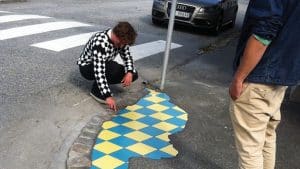It is difficult not to compare him with Banksy, who also adds life to downtrodden city corners and remains unknown.

It is not just Britain that has a problem with potholes. All over Europe there are cracks in roads and pavements uprooted by
sprawling trees.
Ememem, an anonymous artist based in France, has a solution. Since 2016, he has been fixing broken asphalt not by filling in holes with tar and concrete, but by laying down colourful mosaics in cement. Each pattern and design is different.
The young artist works throughout Europe, but mostly in France, Spain, Italy and Norway. He calls his practice “flacking”, now the given term for setting beautiful tiles in broken streets. Some local councils remove the work.
Many allow it to stay there. Some authorities, Ememem says, have started inviting him to flack in their towns: he is finding fame by way of muddled mosaics.
“When I discovered flacking, it didn’t have a name. In fact, it didn’t exist, and neither did I,” he tells i. “Flacking comes from a whole series of experiences I have had with ceramic materials, but above all from an old holey road that accompanied me to work every morning. One day I decided to repair it.”
The term flacking, meanwhile, “jumped out of a bottle of champagne on an evening with friends”, he explains. It was derived from the French word “flaque”, or “puddle”.
“I love working on all aspects of flacking. Walking around the town, listening to the potholes that speak to me, letting myself become carried away by poetry and the smell of wet bitumen. I work in the middle of the night and experience improbable encounters. I love it all”.
The legality of Ememem’s flacking is a grey area. Buildings, he says, are a little harder, but few are likely to complain upon finding a gap in a run-down walkway has been transformed by bright, intricate tiling.
The artist explains: “It depends on where you make them. Many times it has been complicated, but personally I never have the feeling of doing something bad.
“I have never had problems with the police – they often greet me and compliment me and stay to see how it turns out.” He continues: “People tend to be enthused by flacking. The choice of place is mainly dictated by the poetic potential released by different elements: the shape of the hole, its surroundings, its aura, what it has to tell me.
“Potholes tell stories. One in Barcelona told me of a day of clashes between the police and Catalan separatists. Another in Paris told me of an accident between a cyclist and a truck carrying flowers to the market. “Each hole has its own story and I am there to take note, suspend space and time and transform the city into an intimate diary. It is life that draws me to certain areas.”
In February, the Chancellor Rishi Sunak promised a fund of £2.5bn to have Britain’s 10 million potholes repaired. Some might hope Ememem gets there first. “I can’t say much, but very soon the first UK flacking will arrive. And then the Moon, maybe,” he says. Ememem’s ambition is endless.
It is also difficult not to compare him with Banksy, an artist who also adds life to downtrodden city corners, and remains unknown, despite continued speculation. There is also the issue of pretenders – or, more kindly, those who wish to spread flacking further afield.
“I’m someone discreet. I like to stay in the shadows and I don’t say a lot about my future projects. I love to be anonymous. “I don’t know if I started an art or underground movement. Maybe it will take years to tell, but if others start doing it, it would be an honour for a son of bitumen like me. “I have seen some repeat flacking around the world.”
Few flacks, if any, will look as mesmerising as those by Ememem, which spiral from the obscurest of pavement edges. He is, after all, a skilled ceramicist who shows his work in Paris galleries. But he is also willing to teach others to help rid Europe of its potholes.
“Many ask me how to do it. Soon I will make a video where I will reveal the whole recipe. My advice above all is to bring many beers with you because the drying phase can be very long.”
(Article source: Inews)

